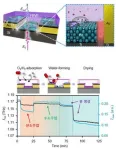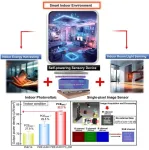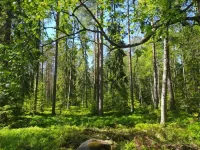(Press-News.org) New findings published in the journal Nature Neuroscience have shed light on a mysterious pathway between the reward center of the brain that is key to how we form habits, known as the basal ganglia, and another anatomically distinct region where nearly three-quarters of the brain’s neurons reside and assist in motor learning, known as the cerebellum.
Researchers say the connection between the two regions potentially changes our fundamental view of how the brain processes voluntary movements and conditioned learning, and may lend fresh insight into the neural mechanisms underlying addiction and neurodegenerative diseases like Parkinson’s.
“We are exploring a direct communication between two major components of our brain’s movement system, which is absent from neuroscience textbooks. These systems are traditionally thought to function independently,” said Farzan Nadim, chair of NJIT’s Department of Biological Sciences, whose research in collaboration with the Khodakhah lab at Albert Einstein College of Medicine is being funded by the National Institutes of Health.
“This pathway is physiologically functional and potentially affects our behaviors every day.”
While both subcortical structures have long been known for their separate roles in coordinating movement through the cerebral cortex, they are also critical to both conditioned and error-correction learning.
The basal ganglia, a group of midbrain nuclei which Nadim describes as the “brain’s go-no-go system” for determining whether we initiate or suppress movement, is also involved in reward-based learning of behavior triggered by the release of dopamine.
“It’s the learning system that promotes motivated behavior, like studying for a good grade. It’s also hijacked in cases of addiction,” said Nadim, co-author of the study. “On the other hand, every behavior that we learn — whether it’s to hit a baseball or play violin — this motor learning is happening in your cerebellum at the back of the brain. It’s your brain’s optimization machine.”
However, the team’s latest research suggests the cerebellum could be involved in both.
In their study, Nadim and collaborators say they have reported the first direct evidence that the two systems are intertwined — showing the cerebellum modulates basal ganglia dopamine levels that influence movement initiation, vigor of movement and reward processing.
“This connection starts at the cerebellum and goes to neurons in the midbrain that provide dopamine to the basal ganglia, called the substantia nigra pars compacta. …. We have brain recordings showing this signal is strong enough to activate the release of dopamine within the basal ganglia,” explained Nadim. “This circuit may be playing a role in linking the cerebellum to motor and nonmotor dysfunctions.”
The team is seeking to identify exactly where cerebellar projections to the dopamine system originate at the nuclei level, a key step in learning whether the function of this pathway can be manipulated, Nadim said.
However, the team’s findings so far could have research implications for neurodegenerative diseases like Parkinson’s, which is associated with the death of dopamine-producing neurons in the substantia nigra.
“This pathway seems very important to our vigor of movement and speed of cognitive processes. Parkinson’s patients not only suffer from suppression of movement, but apathy in some cases,” said Nadim. “The cerebellum’s location at the back of the brain makes it a much easier target for novel therapeutic techniques, such as non-invasive transmagnetic or direct-current stimulation.
“Since we’ve shown the cerebellum is directly exciting dopamine neurons in the substantia nigra, we might now use mouse models for Parkinson’s to explore such techniques to see if that jumpstarts activity of these neurons and relieves symptoms of the disease.”
END
Researchers establish brain pathway linking motivation, addiction and disease
Researchers say one brain region, the cerebellum, may hold more influence over these dopamine neurons than realized.
2024-01-25
ELSE PRESS RELEASES FROM THIS DATE:
How COVID changed the way Americans work, and how much money they have
2024-01-25
According to a new paper in the Review of Economic Studies, published by Oxford University Press, the widespread adoption of work-from-home technology has had dramatic consequences for American life. Using an equilibrium model where people choose where to live and how to allocate their time between working at home and at the office, the researchers here find that the pandemic induced a substantial increase in the relative productivity of those working from home. This change has increased housing prices, reduced office rent costs, and will permanently ...
Development of real-time trace hydrogen gas leakage via a novel terahertz-wave optical platform
2024-01-25
Hydrogen gas is the smallest and lightest of all known molecules, and its colorless and odorless nature makes it easy to leak. Also when concentrated above 4% in a confined space, it poses a risk of ignition or explosion. In order for hydrogen to become a major player in the future energy industry, it is essential to ensure the safety issues via ultra-sensitive gas detection technology over the entire gas-dealing processes such as gas production, storage, and transportation. However, conventional gas-leakage sensors using electric signals are prone to yield electrical sparks, which can cause an explosion of leaked hydrogen gas. In addition, the mainstream electrode-based contact sensors ...
Advanced Full-color image sensor technology enabling simultaneous energy harvesting and imaging
2024-01-25
Organic-based optoelectronic technology is increasingly recognized as an energy-efficient solution for low-power indoor electronics and wireless IoT sensors. This is largely due to its superior flexibility and light weight compared to conventional silicon-based devices. Notably, organic photovoltaic cells (OPVs) and organic photodetectors (OPDs) are leading examples in this field. OPVs have the remarkable ability to absorb energy and generate electricity even under very low light condition, while OPDs are capable of capturing images. However, despite their potential, the development ...
New analysis shows that disinfection is the most effective way to prevent viral contamination of restroom surfaces
2024-01-25
Arlington, Va. — January 25, 2024 — A new study published today in the American Journal of Infection Control (AJIC) demonstrates that viral particles spread to many restroom surfaces during toilet flushing, regardless of whether the toilet lid is up or down. In this analysis, the only meaningful way of reducing viral particles was through disinfection of the toilet, toilet water, and nearby surfaces.
Scientists have long known that the process of toilet flushing can aerosolize pathogens expelled into the toilet bowl by an unhealthy individual. The aerosol plume created from the force of flushing can ...
Diverse forests are best at standing up to storms
2024-01-25
European forests with a greater diversity of tree species are more resilient to storms, according to new research published in the British Ecological Society journal, Functional Ecology.
A new study by researchers at the French National Research Institute for Agriculture, Food and Environment (INRAE) reveals that in Europe, the forests that are most resilient to storms are those with a greater diversity of tree species and dominated by slow growing species with high wood density, like oaks.
The researchers also found that the positive effect of ...
More reporting needed to show progress on Ontario municipal climate and sustainability plans
2024-01-25
While sustainability reporting is a widespread practice in the private sector, new research shows that the same cannot be said for Ontario municipalities.
Researchers at the University of Waterloo studied 38 municipalities in Ontario, representing more than two-thirds of the population, and discovered that almost all municipalities publish their sustainability and climate change goals, but under half are formally reporting on their progress.
Municipalities are a key part of the equation ...
Recovering lossless propagation: HKU physicists overcoming optical loss in polariton system with synthetic complex frequency waves
2024-01-25
A collaborative research team co-led by Professor Shuang ZHANG, the Interim Head of the Department of Physics, The University of Hong Kong (HKU), along with Professor Qing DAI from National Center for Nanoscience and Technology, China, has introduced a solution to a prevalent issue in the realm of nanophotonics – the study of light at an extremely small scale. Their findings, recently published in the prestigious academic journal Nature Materials, propose a synthetic complex frequency wave (CFW) approach to address optical loss in polariton propagation. These findings offer practical solutions such as more efficient light-based devices for faster and ...
HKU Common Core and HKUMed teams win one Silver and one Bronze in QS Reimagine Education Awards
2024-01-25
Two innovative teaching and learning projects led by The University of Hong Kong (HKU) earned honours in the Quacquarelli Symonds (QS) Reimagine Education Awards, presented in Abu Dhabi in December 2023.
Often referred to as the "Oscars of Education," the awards are designed to honour the most innovative and effective approaches to enhancing student learning experiences and employability outcomes.
The 2023 QS Reimagine Education Awards received a record number of more than 1,200 submissions across 17 categories. HKU has garnered ...
A pathway to environmental restoration: Sustainable strategies for cesium removal from radioactive wastewater
2024-01-25
The Fukushima Daiichi nuclear disaster, triggered by the earthquake and tsunami on March 11, 2011, resulted in a severe release of radioactive materials, including cesium, from the damaged nuclear reactors. The loss of cooling capabilities led to partial meltdowns in the reactor cores, releasing a substantial amount of cesium-137 (Cs-137) and cesium-134 (Cs-134) into the environment. The release of Cs-137, in particular, poses environmental and human health hazards due to its long half-life and high mobility in the environment. Environmentally, Cs-137 contributes ...
A building rising from the hilltop—Three topographical approaches to building in a landscape
2024-01-25
This essay writes on a building project in the remote southwestern China that is built in uninhabited and is inspired and informed by its landscape context. The essay discusses how an extraordinary building project reacts to three different dimensions about landscape–architecture—a natural terrain being manipulated and recast. A small building needs to find its precise connecting point to a much larger historical and environmental context. A practical project needs to reach a balance between architectural pursuits and engineering concerns. Initially, artificial works might be isolated from and in conflict with the terrain, which requires architectural approaches ...
LAST 30 PRESS RELEASES:
New UBCO research challenges traditional teen suicide prevention models
Diversity language in US medical research agency grants declined 25% since 2024
Concern over growing use of AI chatbots to stave off loneliness
Biomedical authors often call a reference “recent” — even when it is decades old, analysis shows
The Lancet: New single dose oral treatment for gonorrhoea effectively combats drug-resistant infections, trial finds
Proton therapy shows survival benefit in Phase III trial for patients with head and neck cancers
Blood test reveals prognosis after cardiac arrest
UBCO study finds microdosing can temporarily improve mood, creativity
An ECOG-ACRIN imaging study solves a long-standing gap in metastatic breast cancer research and care: accurately measuring treatment response in patients with bone metastases
Cleveland Clinic presents final results of phase 1 clinical trial of preventive breast cancer vaccine study
Nationally renowned anesthesiology physician-scientist and clinical operations leader David Mintz, MD, PhD, named Chair of the Department of Anesthesiology at the UM School of Medicine
Clean water access improves child health in Mozambique, study shows
Study implicates enzyme in neurodegenerative conditions
Tufts professor named Fellow of the National Academy of Inventors
Tiny new device could enable giant future quantum computers
Tracing a path through photosynthesis to food security
First patient in Arizona treated with new immune-cell therapy at HonorHealth Research Institute
Studies investigate how AI can aid clinicians in analyzing medical images
Researchers pitch strategies to identify potential fraudulent participants in online qualitative research
Sweeping study shows similar genetic factors underlie multiple psychiatric disorders
How extreme weather events affect agricultural trade between US states
Smallholder farms maintain strong pollinator diversity – even when far from forests
Price of a bot army revealed across hundreds of online platforms worldwide – from TikTok to Amazon
Warblers borrow color-related genes from evolutionary neighbors, study finds
Heat signaling from plants is an ancient pollinator signal
New index reveals the economics underlying the online manipulation economy
High-resolution satellite observations reveal facility-level methane emissions worldwide
Researchers discover how Ebola and Marburg disrupt the gastrointestinal tract
Feeling the heat
Eastward earthquake rupture progression along the Main Marmara Fault towards Istanbul
[Press-News.org] Researchers establish brain pathway linking motivation, addiction and diseaseResearchers say one brain region, the cerebellum, may hold more influence over these dopamine neurons than realized.






